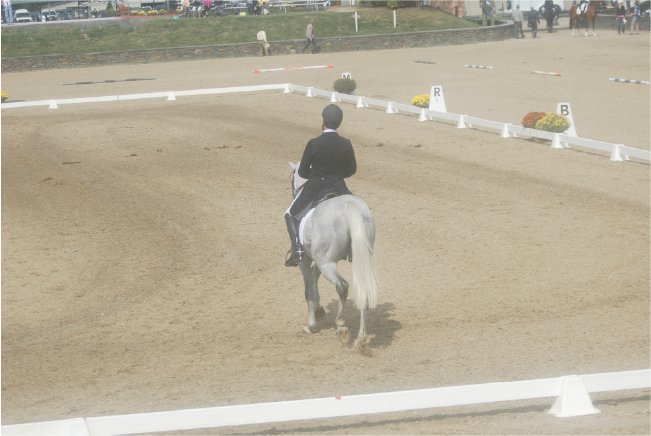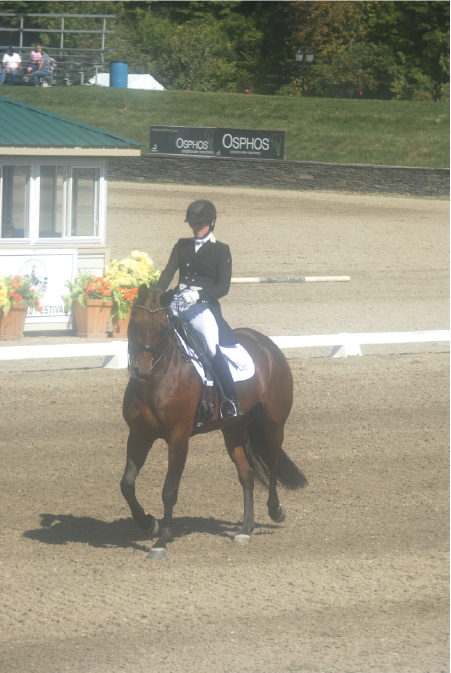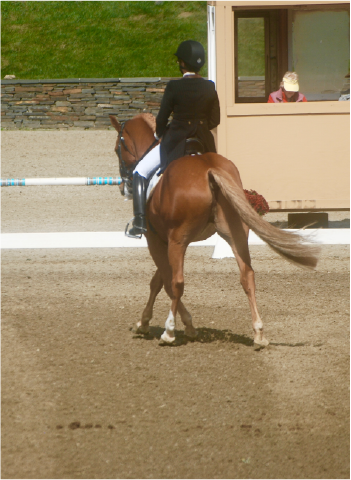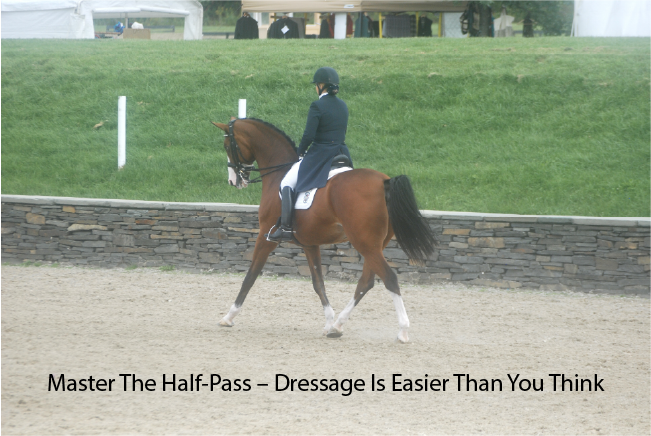Master The Half-Pass – Dressage Is Easier Than You Think
By Nikki Alvin-Smith
Dressage training is much easier to do than you may think. It just takes some focus and understanding of the processes involved and knowledge of when and why it is time to move along to the next basic task in training. Today’s use of video technology that can mark your progress in real time for play back and earnest evaluation. This means there truly is no excuse not to be able to find training help wherever you live. Even if you are not fortunate enough to have one close by to step up and help.
The half-pass should be a floating effortless movement for the horse. This is one of my favorite movements to ride, as this lateral movement truly is a dance. It is also one of the most beneficial movements for the horse as it helps to develop suppleness in the horse’s back particularly in his sacro-iliac area. It affirms whether the horse is evenly engaging both hind legs and whether he is lifted and free in his shoulders and truly moving forward to the bit with a soft correct contact. It also enhances his ability to shift his center of gravity and to flex and develop his musculature as on one side his muscles are contracted (concave side) and the other the muscles are elastic and stretching (convex side).
Why are so many riders seen traversing the show arena in various contorted body position with their horse in poor frame? The horse becomes stuck and ‘backward,’ the horse either above the bit or behind the vertical. Where did they go wrong?
In this article we will focus on the half-pass at the trot.
Let’s take a look at a good half-pass. The hoof falls should be in even rhythm and of even distance in stride. In this lateral movement on a diagonal path the horse should be looking in the direction of travel. As the horse advances in his training his ability to ‘cross his legs’ will become more fluid and more extension will come to the stride and crossover. The horse’s body (spine) should remain parallel to the side of the arena with the shoulders very slightly leading the movement. The horse’s spine should be bent slightly to the direction of travel. Hind legs should not lead or trail behind the shoulder. The rider should be able to see the inside eye of the horse with a slight bend in the poll as the horse looks to the direction of travel.
The rider should also look in the direction of the movement. It is best to look for the letter ‘point’ at the side of the arena as you travel in that direction and to end the half-pass one step before you find the track. The rider’s body should be upright with a very slight drop of weight in the seat to the direction of travel encouraging the horse to step up and under and take the weight. This weight ‘drop’ is naturally developed as the rider’s leg to the side of the direction of travel, the inside leg, will be just behind the girth while the outside leg will be slightly further behind the girth. This leg position will automatically lighten the seat on the outside effectively ensuring the rider’s inside seat bone carries more weight. The rider will use the outside leg in a tapping motion not in a holding position against the horse’s side. To hold will cause the horse to push against the leg instead of moving away from it. The rider’s inside leg will be actively tapping on the horse’s side at the girth to create the energy, bend and the forward movement and to keep the inside hind leg of the horse engaged while the outside leg will create the sideways movement and ask for increased engagement of the haunches on that side.
The rider’s seat must be deeply anchored and as always his spine should be aligned with that of the horse.
The rider will have a light contact on the inside rein and give small half halts as needed on either rein to correct the shoulder position. The ‘wall’ is the outside rein and this will hold the shoulder and encourage the horse to move sideways rather than straight forward. Half halts will be given on the outside rein to correct the pace of the gait and limit the forward movement asking for more collection. The outside rein will also control the degree of flexion.
The rider should always think of the first stride as a forward stride and not as a sideways stride. Think ‘forward, side, forward, side,’ as you school the movement.
The ‘draping’ rider will work with the balance of the horse both longitudinally and laterally and allow their hips to be free and work with the movement without gripping or tension unless correction is needed in the movement in which case a slight stiffening of the back or temporary ‘hold’ may be needed to prevent too much sideways movement.
The rider should also check their breathing. As the horse moves forward, the rider breathes out, as the horse moves laterally, the rider breathes in.
In early training just a few quality strides of lateral movement should be rewarded by riding the horse straight for a few strides before returning to the ask for the half-pass. The number of strides being gradually increased as the horse finds his balance and his suppleness improves. If the horse falters at all in the lateral movement he should be immediately ridden straight. After any lateral work it is a good idea to ride the horse forward in a medium or extended trot to keep his mind and your own mind thinking forward. A medium canter can also be employed for a more phlegmatic horse.
What are the pre-requisites for training the half-pass?
Your horse must have an excellent shoulder in, renvers (haunches-out) and travers (haunches-in). Before you begin training any lateral movement ensure you can complete the turn on the forehand and that your horse understands how to move away from your leg pressure. Once this is established the non-classical turn on the forehand movement may be discarded. Your horse should also have mastered the walk pirouette and understand how to turn correctly on his haunches which should have been developed from the haunches-in.
It is imperative that the horse has good collection and is truly in front of the rider’s leg and on the aids and that he works evenly in both reins and is straight. Train the lateral movements at the walk first, then the trot and then the canter. I do not recommend working haunches in on a straight line at the canter because horses invariably want to travel with their haunches to the inside and we don’t need to encourage that behavior.
There are many options to set up the movement and it will depend on your individual horse as to what works best. For most horses it is easiest to start to the right. You can begin the movement from a ten meter circle at shoulder-in to the right at the end of the arena. Make a circle in the corner and as you arrive at the center line simply straighten the horse for one stride and then continue the bend to the right and ask for a lateral step or two. Horses are naturally magnetized to the arena wall so you will find your horse is happy to head in that direction.

You can also ride out of the short side in the corner of the arena using a shoulder in position through the bend of the corner and ride off the wall toward the center line as you exit the corner applying the outside leg aid (left leg) to the shoulder-in to move the haunches over.
Both the circle and the corner give you an opportunity to collect the horse in readiness for the movement. If you do not have a quality collected trot and a horse that is light in the shoulders do not attempt the movement for it will fail. The horse must add engagement of his inside leg and step more up and under himself to be responsible for his own shoulders and you must be responsible for yours. You should match your shoulders to his shoulder position i.e. be square with your horse.
The leg aids should be given by extending the leg down in the thigh and not by bringing the leg up and back. If you have made a cardinal error in training your horse to the canter by just using an outside leg aid for the depart to canter then whenever you ride the half-pass he may throw in a stride of canter. Whoops! You need to retrain the horse in his canter depart by adding the inside leg and use your outside leg a little farther back for the half-pass to allow him to differentiate. Be sure to also keep your eyes front and center in the canter depart but in the half-pass turn your head to the direction of travel two strides before you ask for half-pass.
 It is helpful to slightly slow the horse down as you train the half-pass in the beginning. On no account should the horse rush away from the aids. The inside rein offers an ‘open door’ to which the horse can step with his shoulder and must not be tight or held. The inside rein is the suppling rein here. The timing of that yield of the rein is when the horse’s inside hind leg leaves the ground. The rider’s hands can move slightly toward the direction of travel together to the point that the outside hand is just to the left of the wither. The hand should not cross the spine. If your horse twists his head, then your rein aid on one side is too strong. I like to say in my clinics,” No holding anywhere and no freezing up.”
It is helpful to slightly slow the horse down as you train the half-pass in the beginning. On no account should the horse rush away from the aids. The inside rein offers an ‘open door’ to which the horse can step with his shoulder and must not be tight or held. The inside rein is the suppling rein here. The timing of that yield of the rein is when the horse’s inside hind leg leaves the ground. The rider’s hands can move slightly toward the direction of travel together to the point that the outside hand is just to the left of the wither. The hand should not cross the spine. If your horse twists his head, then your rein aid on one side is too strong. I like to say in my clinics,” No holding anywhere and no freezing up.”
You can also train the half-pass by working down the center line in a haunches-in to the right position. A haunches-in would generally have more cross over of the legs than a half-pass. With all lateral work it is generally easiest to train the movement first on the long side, then on the center line and then across the diagonal.
When teaching riders in clinics I used to suggest to the rider that they could equate the preparation for lateral work and transitions with driving a manual car. Unfortunately some folks don’t know how to drive a manual or stick, but for those that did I believe they found the analogy helpful. To ride any lateral movement or transition correctly you must have enough gas in the engine and have the car revved high before you change ‘up’ i.e. have enough collection and hind leg activity. If the horse is not working in high revs then when you change gear and add the new movement or gait, the horse will falter and maybe stall out altogether.
When training the half-pass it is good to ‘refresh’ your horse by doing a few steps of half-pass and then circling right for a few circles before leaving the circle in half-pass position once again.
Obviously for a half-pass to the left these aids are reversed. The rider must always stay in balance with the horse and not tilt to the side.
One of my trainers used to put shavings on the ground in the arena to describe to her students the line that the front legs of the horse should follow. I have used this to teach students how to ride a correct circle too!
Common Mistakes
The horse does not move away from the outside leg or his haunches trail behind his shoulders or his legs do not cross. To resolve this issue the rider takes more pressure on the inside rein effectively now blocking the horse from moving away from the outside leg pressure.
Answer: Work on your horse’s attention to the outside leg by working on counter flexion in shoulder-in (shoulder-out) and run through renvers and travers movements. Still not listening? Add some walk pirouettes. Still not listening? Add some spur or whip to the outside aid.
 The strides of the trot become short and the horse becomes tense. This is usually the rider using aids that are too strong or not setting the horse up with the right tempo or energy or the rider is asking for too much bend and cross over. Answer: Work with your horse at the walk to be sure he understands the aids. When back in the trot try using less aid and be certain you are not holding the inside rein. Slow your horse down and see if you can find a better rhythm where he can relax.
The strides of the trot become short and the horse becomes tense. This is usually the rider using aids that are too strong or not setting the horse up with the right tempo or energy or the rider is asking for too much bend and cross over. Answer: Work with your horse at the walk to be sure he understands the aids. When back in the trot try using less aid and be certain you are not holding the inside rein. Slow your horse down and see if you can find a better rhythm where he can relax.
The horse speeds up during the half-pass. Answer: Take your shoulders slightly to the outside for a stride and then place them back parallel to the horse’s spine. If your horse runs off after a half-pass either start your half-pass farther down the school and end it by the short side wall send him forward before you reach the track and/or ride him in the last strides of half-pass in the walk.
The horse’s haunches lead or the shoulder isn’t moving. Answer: Be certain you are not blocking on the inside rein and are providing the ‘open door’ as his inside hind leg leaves the ground. If his haunches are leading your outside leg is either too far back or your leg is too strong. Also be certain you are not using too much outside rein and blocking him from moving his shoulder to the inside.
It is always beneficial to work the half-pass with lots of shoulder-in between to remind the horse to be light and on the leg aids.
About the Author: Nikki Alvin-Smith is an international level Grand prix dressage competitor with scores to over 72%. As a busy clinician/coach teaching worldwide, she and her husband Paul (also a Grand Prix dressage rider), have developed many horses and riders to advanced levels, including both imports and homebred horses.
They currently run their private training yard Willowview Hill Farm, located in the Catskill Mountains in Stamford, New York. Nikki is also a published author and professional content writer with over 230 different magazine entities in her portfolio that have published thousands of her works over the years. The Horse Studio Inc., is currently filming an equestrian program based on their training methods - "Road Map To Making The Grand Prix Dressage Horse. Part 1" of the series "101 Dressage ~ The Young Horse"




